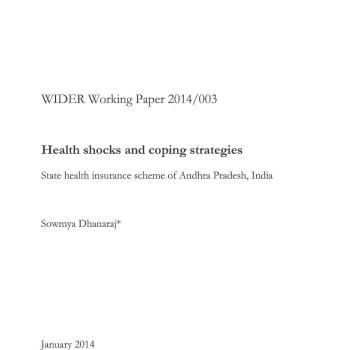Publication Information

The objectives of the study are three-fold: to investigate who are vulnerable to welfare loss from health shocks, what are the household responses to cope with the economic burden of health shocks and if policy responses like state health insurance schemes are effective in reducing the economic vulnerability. Existing literature have investigated the impact of state health insurance schemes in reducing the vulnerability to financials risks of medical care using catastrophic health expenditure (CHE) measure. This has several limitations like setting arbitrary threshold levels, exclusion of those that did not seek medical care due to inability to pay and non-accounting for risks posed by different sources of financing. So we use self-reported measure of reduction in economic wellbeing of households due to serious illness or death of one or more members from the recent Young Lives longitudinal study in Andhra Pradesh, India. Three-level random intercept logistic regression analysis that accounts for role of contextual or environmental factors like access to healthcare is used to determine the characteristics of vulnerable population and effectiveness of the state insurance scheme.
Paper written by Sowmya Dhanaraj (PhD candidate at IGIDR, Mumbai) using Young Lives data from UK Public Data Archive.
Keywords: health shocks, coping strategies, state health insurance scheme, three-level random intercept model
JEL classification: I100, I130, O150

The objectives of the study are three-fold: to investigate who are vulnerable to welfare loss from health shocks, what are the household responses to cope with the economic burden of health shocks and if policy responses like state health insurance schemes are effective in reducing the economic vulnerability. Existing literature have investigated the impact of state health insurance schemes in reducing the vulnerability to financials risks of medical care using catastrophic health expenditure (CHE) measure. This has several limitations like setting arbitrary threshold levels, exclusion of those that did not seek medical care due to inability to pay and non-accounting for risks posed by different sources of financing. So we use self-reported measure of reduction in economic wellbeing of households due to serious illness or death of one or more members from the recent Young Lives longitudinal study in Andhra Pradesh, India. Three-level random intercept logistic regression analysis that accounts for role of contextual or environmental factors like access to healthcare is used to determine the characteristics of vulnerable population and effectiveness of the state insurance scheme.
Paper written by Sowmya Dhanaraj (PhD candidate at IGIDR, Mumbai) using Young Lives data from UK Public Data Archive.
Keywords: health shocks, coping strategies, state health insurance scheme, three-level random intercept model
JEL classification: I100, I130, O150

